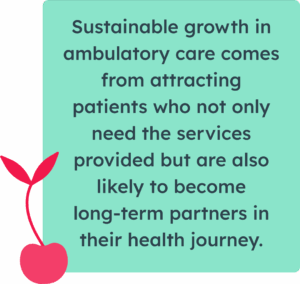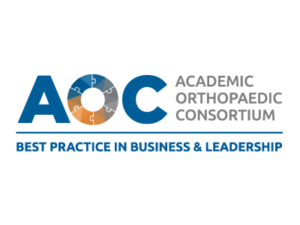Health systems across the country are changing how they approach growth. The traditional model of expanding through acute care facilities is giving way to a new reality where ambulatory care represents one of the fastest-growing and highest-margin segments of the healthcare industry.
 For Chief Growth Officers and other healthcare growth leaders, this shift creates both significant opportunities and complex challenges. The real question is how to expand efficiently, effectively, and profitably. Success depends on understanding that not all patients are created equal. The future belongs to organizations that can precisely target their ideal patient populations.
For Chief Growth Officers and other healthcare growth leaders, this shift creates both significant opportunities and complex challenges. The real question is how to expand efficiently, effectively, and profitably. Success depends on understanding that not all patients are created equal. The future belongs to organizations that can precisely target their ideal patient populations.
The Ambulatory Advantage: Why Health Systems Are Pivoting
The numbers tell the story: outpatient procedures are expected to grow by more than 15% over the next decade, while inpatient discharges will see only 2% growth. This shift is driven by payers pushing value-based care contracts, patients facing high-deductible plans, and new competitors promising to disrupt traditional healthcare delivery. These pressures are forcing health systems to develop cost-effective strategies that extend well beyond hospital walls.
The Hidden Cost of Broad-Brush Marketing
One of the most significant challenges facing healthcare growth leaders today is the rising cost of patient acquisition. Statistical data from 2023 shows that the average patient acquisition cost for primary care practices was $125 per patient, while it reached $200 per patient for specialty clinics. For large health systems operating multiple ambulatory locations and specialties, these costs can quickly spiral out of control.
The problem with traditional marketing approaches is that they cast too wide a net. When health systems market their ambulatory services to everyone, they end up attracting patients who may not be the best fit for their specific service lines, locations, or strategic objectives. This leads to inflated acquisition costs, lower conversion rates, and reduced patient lifetime value (PLV).
The Ideal Patient Profile: Beyond Demographics
Successfully scaling ambulatory services requires a sophisticated understanding of what constitutes an “ideal patient” for each service line and location. This goes far beyond traditional demographic segmentation to include factors like treatment complexity, insurance coverage, geographic accessibility, and propensity for ongoing care relationships.
For ambulatory surgical centers, ideal patients might include those requiring common procedures with favorable reimbursement rates, minimal complications, and strong adherence to post-operative care protocols. For primary care clinics, the focus might shift toward patients with chronic conditions requiring ongoing management, families seeking comprehensive care, or individuals with employer-sponsored insurance plans.
The key is recognizing that ideal patient profiles vary significantly across different ambulatory service lines. A dermatology clinic’s ideal patient differs dramatically from an orthopedic surgery center’s target population. Health systems that try to apply one-size-fits-all marketing strategies across their entire ambulatory network inevitably waste resources and miss opportunities.
Data-Driven Precision: The New Competitive Advantage
This is why the most successful health systems are leveraging advanced data analytics to identify and target their ideal patient populations with laser-like precision. This approach goes beyond traditional demographic data to incorporate behavioral patterns, healthcare history, and predictive modeling based on thousands of HIPAA-compliant data points.
Predictive patient targeting allows health systems to proactively identify individuals who are most likely to need specific ambulatory services, have the ability to pay for them, and demonstrate characteristics associated with positive outcomes and long-term relationships. This scientific approach to patient acquisition can dramatically improve conversion rates while reducing overall marketing costs.
 The ROI Revolution: Measuring What Matters
The ROI Revolution: Measuring What Matters
Traditional healthcare marketing often struggles with attribution and ROI measurement, making it difficult for growth leaders to justify marketing investments or optimize campaigns. The shift toward ambulatory care creates an opportunity to implement more sophisticated measurement systems that track patient value from initial acquisition through ongoing care relationships.
Operating under the general industry standard that for every $1 spent on marketing, $3 should be generated from the customer throughout their customer lifetime, successful health systems are implementing comprehensive PLV and ROI tracking systems. These systems connect initial acquisition costs to ongoing revenue from appointments, procedures, and referrals, providing a complete picture of marketing effectiveness.
This approach allows growth leaders to make data-driven decisions about resource allocation across different service lines and locations. Rather than spreading marketing budgets evenly across sites, systems can invest more heavily in targeting strategies that demonstrate higher returns.
Overcoming Organizational Silos
One of the most persistent challenges in healthcare marketing is the disconnection between different departments and service lines. Patient feedback doesn’t inform growth strategies, marketing efforts aren’t aligned with clinical priorities, and insights get lost in organizational silos.

Successful ambulatory growth requires integrated systems where patient experience data directly informs targeting strategies and removes barriers. When patient satisfaction scores, clinical outcomes, and utilization patterns are combined with marketing performance data, health systems can develop more effective and sustainable growth strategies.
The solution involves implementing unified platforms that provide holistic views of patient journeys across all touchpoints. This integration allows leaders to understand not just how patients are acquired, but how they progress through the care continuum. It provides insight into what factors influence their long-term value to the organization.
The Technology Imperative
Technology advances in the industry are making it easier for health systems to transform their approach to ambulatory growth. From predictive analytics platforms that identify high-value patient segments to automated feedback systems that capture patient voice in real-time, technology is enabling more precise and effective growth strategies.
Technology also enables more efficient campaign management across multiple locations and service lines. Rather than managing separate marketing efforts for each ambulatory site, health systems can leverage centralized platforms. This allows for coordinated strategies while maintaining local relevance and customization.
Building Sustainable Growth
The goal of patient targeting goes beyond filling appointment schedules. It’s about building sustainable growth that creates value for patients, providers, and the overall health system. This requires a long-term perspective that prioritizes patient-relationship building over short-term volume metrics.
 Sustainable growth in ambulatory care comes from attracting patients who are likely to become long-term partners in their health journey. These patients typically have better clinical outcomes, higher satisfaction scores, and greater propensity to refer others to the organization.
Sustainable growth in ambulatory care comes from attracting patients who are likely to become long-term partners in their health journey. These patients typically have better clinical outcomes, higher satisfaction scores, and greater propensity to refer others to the organization.
Those that will thrive in ambulatory care are the ones that can efficiently identify, attract, and retain these ideal patients across their entire network. This requires a combination of sophisticated targeting strategies, integrated feedback systems, and a commitment to continuous improvement based on data-driven insights.
The transformation requires more than just new technology or tactics. It demands a mindset shift in how health systems think about growth. It’s time to shift from volume-based approaches to value-based strategies that prioritize quality relationships over quantity of interactions. The tools and strategies exist today to make this vision a reality. The question is which organizations will have the courage and commitment to embrace this new paradigm.
The ambulatory care revolution is already underway. The health systems that recognize patient targeting as a strategic advantage will emerge as leaders in the new healthcare landscape.











